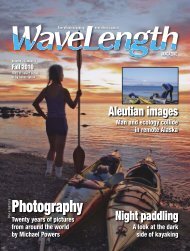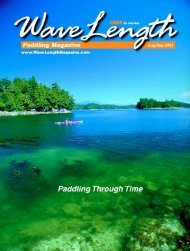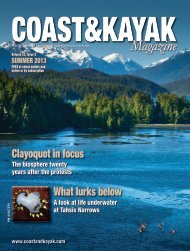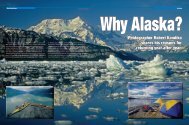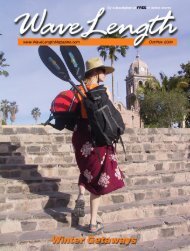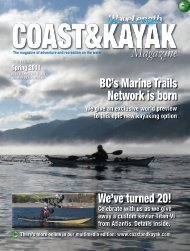Download - WaveLength Paddling Magazine
Download - WaveLength Paddling Magazine
Download - WaveLength Paddling Magazine
You also want an ePaper? Increase the reach of your titles
YUMPU automatically turns print PDFs into web optimized ePapers that Google loves.
cal community which decries music, where<br />
the womenfolk wear dresses down to their<br />
feet and their hair to their waists.<br />
There are many old shipwrecks all along<br />
the coast, which is a draw for divers. On<br />
the ocean side of this island too, beach<br />
landings are often tricky due to the steep<br />
slopes of the beach and the big surf.<br />
BRAZIL IN GENERAL<br />
Brazil is is a huge country, largely covered<br />
in lush tropical rainforests. The Amazon<br />
basin alone has one-fifth of all the earth’s<br />
fresh water reserves. With a coastline of almost<br />
8,000 kilometers of sandy beaches, and<br />
boasting a warm climate year round, Brazil<br />
offers some of the most pleasant leisure spots<br />
in the world. Bathed by the warm waters of<br />
the southern Atlantic Ocean, it’s perfect all<br />
year round for diving, swimming, snorkeling,<br />
surfing and kayaking.<br />
Brazil has a Portuguese-speaking population<br />
of 170 million, of which 70% are<br />
Roman Catholic. It is a peaceful, economically<br />
stable democracy, the 9th largest<br />
economy of the world. In many coastal areas<br />
there are lots of excellent 4 and 5 star<br />
hotel resorts and sophisticated little inns.<br />
Brazilians are an extremely friendly,<br />
warm, extroverted people. The hot climate<br />
allows them to spend most of the time out-<br />
Comprida, a long, low island,<br />
along Ilha Cardoso and<br />
Superagui. Setting out to sea<br />
or making surf landings here<br />
always poses a challenge,<br />
since it means running the<br />
gauntlet through surf from 6-<br />
10 feet high, extending a few<br />
hundred yards.<br />
But on Cardoso you can<br />
get home cooking and<br />
seafoods at inexpensive<br />
prices from the simple, gentle<br />
people here who still cling<br />
to their centuries’ old lifestyles,<br />
fishing and planting,<br />
with few modern devices or<br />
electricity.<br />
About 500km further south, in the State<br />
of Santa Catarina, the beautiful island of<br />
Florianopolis beckons with its 100 sandy<br />
beaches, many of which are a surfer’s paradise.<br />
This area has had a great Portuguese<br />
influence on its culture, architecture, festivities,<br />
fishing and agriculture, by people<br />
coming from the Azores islands in the Atlantic<br />
(originally colonized by the Portuguese),<br />
who settled on this Island in the<br />
south of Brazil centuries ago.<br />
This region of Brazil is very beautiful but<br />
far more populated, with sophisticated tourist<br />
resorts and first world-class hotels and<br />
restaurants. The coast on the inside is<br />
densely populated, while the external south<br />
side is far less so. Here too are the Three<br />
Sister Islands, a little cluster of islands an<br />
hour’s paddling off the coast.<br />
On this ocean side of the island, just<br />
north of Santinho beach, is a rocky stretch<br />
with Indian rock paintings over 5,000 years<br />
old. Further south is the island’s famed<br />
Galhetas nudist beach.<br />
In the middle of the island are two large<br />
fresh-water lagoons, surrounded by mountains.<br />
The island also has some very large<br />
sand dunes, which are the delight of ‘sand<br />
boarders’ or ‘dune surfers’, who imitate the<br />
antics of snowboarders in colder climes.<br />
Further north off the coast, a little south<br />
of Rio de Janeiro, is a region of over 370<br />
islands. The largest, Ilha Grande, offers great<br />
paddling adventures. Here too the ocean<br />
side of the island is the least inhabited, in<br />
fact almost totally deserted except for a few<br />
small fishing settlements on two beaches.<br />
The island has many historic sites and ruins.<br />
Freguesia de Santana Leste beach has<br />
a church dating from 1796 with pirates buried<br />
in its cemetery as well as a house which<br />
used to belong to a famous Spanish pirate<br />
called Juan Lorenzo. At Cachadao beach<br />
there is a road built by slaves of rock which<br />
goes 3km to the next beach, Dois Rios,<br />
where there are ruins of a penitentiary. At<br />
Proveta beach there is a secluded evangelidoors,<br />
often just chatting with<br />
friends or people watching.<br />
They have an incredible<br />
sense of humour, and are extremely<br />
irreverent—any incident,<br />
good or bad, immediately<br />
sets off an enormous<br />
number of jokes.<br />
What Brazilians love most<br />
is their outdoors, especially<br />
their beaches, around which<br />
everything seems to revolve.<br />
If you look at a map of Brazil<br />
you will see that the great majority<br />
of the cities have developed<br />
along the coastline, due<br />
to the great coastal mountain<br />
range going all the way north.<br />
Even still, there are many uninhabited areas<br />
with deserted beaches along the coast.<br />
Check this site for some beaches: http://<br />
www.uol.com.br/guiadolitoral/index.htm.<br />
The site is in Portuguese but the views are<br />
beautiful.<br />
It is important to note that there are some<br />
very interesting cultural differences as you<br />
travel throughout Brazil. In the south, a great<br />
European influence is easily seen. In Parana<br />
state there are towns you would imagine<br />
finding in the Ukraine or Poland. In other<br />
parts of the same state, there are strong Italian<br />
and German influences. In the State of<br />
Sao Paulo, strong Portuguese, Japanese and<br />
other cultural traits can be found. In the<br />
north, in the State of Bahia, the influence<br />
of the former Afican slaves of the sugar-cane<br />
plantations is very strong.<br />
It’s a country of strong contrasts and wonderful<br />
blends. ❏<br />
Guido Botto photo<br />
© Guido Botto, a Canadian, has lived almost<br />
30 years in Brazil. Fluent in English, Portuguese,<br />
Italian and Spanish, he runs a translation<br />
and interpretation agency. In 1999 he won<br />
Brazil’s non-stop 5-day, 5-night Eco Challenge<br />
Adventure Race. He is now developing an ecoadventure<br />
tourism business to guide Canadians<br />
on kayak trips in Brazil, and to bring Brazilians<br />
to Canada for kayaking. Ph: 250-714-5609,<br />
gbotto@shaw.ca, www.kayakingbrazil.com.<br />
October/November 2002 www.<strong>WaveLength</strong><strong>Magazine</strong>.com<br />
17




